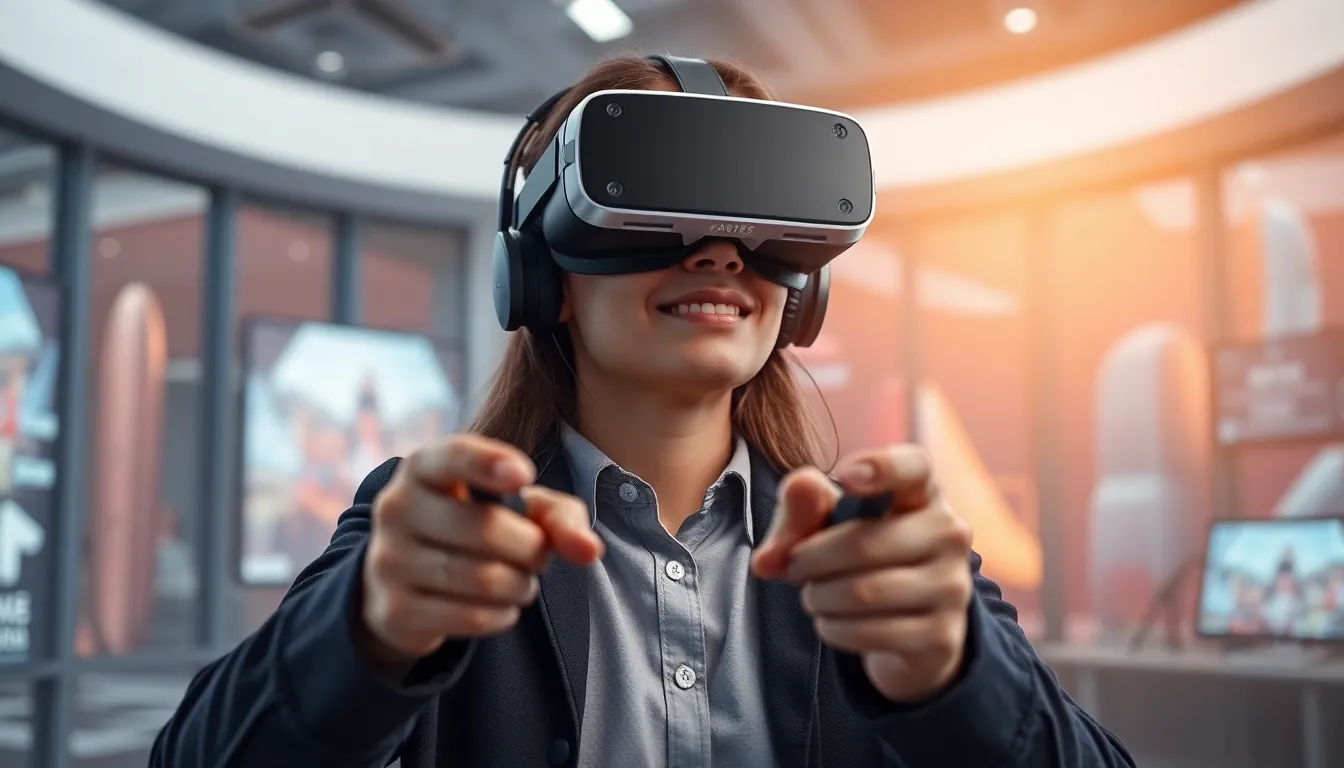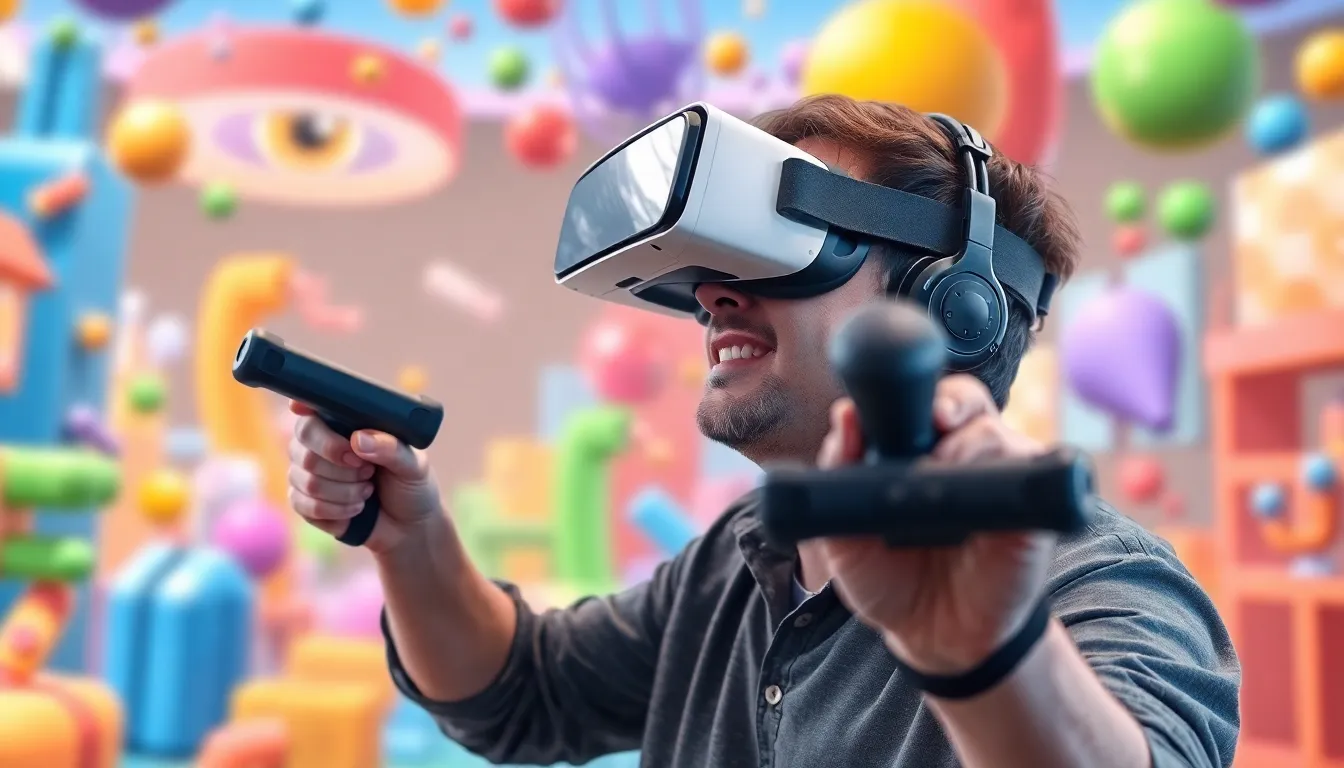Table of Contents
ToggleVirtual reality development is like stepping into a sci-fi movie where the only limit is imagination. Gone are the days of clunky headsets and pixelated worlds; today’s VR tech is smoother than a buttered otter sliding down a rainbow. As developers dive into this exciting realm, they’re not just creating games—they’re crafting immersive experiences that can transport users to fantastical worlds or even teach them how to juggle flaming swords (safely, of course).
Overview Of Virtual Reality Development
Virtual reality development encompasses the creation of immersive digital environments that engage users in unique ways. Innovations in hardware and software have dramatically shifted the landscape, enabling designers to push the limits of imagination. High-resolution displays and advanced motion tracking allow users to experience a sense of presence and interactivity that was previously unattainable.
Developers today focus on diverse applications beyond gaming, including education, healthcare, and training simulations. These applications capitalize on the immersive nature of VR to enhance learning experiences and practical skills. For instance, medical training can utilize realistic simulations, allowing practitioners to hone their skills before entering high-stakes environments.
Core components of VR development include 3D modeling, animation, and programming. Artists create lifelike avatars and settings that immerse users in rich details. Programmers ensure that interactions feel natural and responsive, using languages and engines such as C# and Unity. Adopting appropriate design philosophies and methodologies often leads to the best results.
The rise of accessibility in VR technology enables more creators to enter the space. Affordable hardware such as Oculus Quest and HTC Vive has broadened the audience, making it easier for developers to produce innovative content. As a result, the industry witnesses a surge in unique experiences tailored to various interests and needs.
Collaboration among experts also drives forward VR development. Engineers, designers, and storytellers combine their talents to craft compelling narratives and environments. This teamwork produces experiences that resonate with users and firmly establish VR as a transformative medium in entertainment and beyond.
Key Technologies In Virtual Reality Development


Virtual reality (VR) development relies heavily on advanced technologies to create immersive experiences. Both hardware and software play crucial roles in shaping user engagement and interaction.
Hardware Components
VR hardware includes headsets, controllers, and sensors. Headsets like the Oculus Quest 2 and HTC Vive Pro offer high-resolution displays and wide field of view. Controllers enable natural hand movements, enhancing user interactivity. Sensors track user movements in real-time, ensuring accurate positioning within a virtual environment. These components collectively provide the necessary tactile feedback and visual fidelity that users expect from modern VR experiences. Other peripherals such as haptic suits immerse users further by simulating sensations, creating a holistic experience of presence.
Software Components
Software is essential for rendering 3D environments and interactions. Game engines like Unity and Unreal Engine provide powerful tools for developers. They offer integrated features, such as physics simulation and advanced rendering techniques. VR development kits from major platforms further assist creators by simplifying the coding process. Scripts are utilized to define user interactions, behavioral patterns, and scene transitions. Additionally, specialized software enables artists to create realistic animations and lifelike avatars, enhancing visual storytelling. These software elements combined result in engaging experiences that captivate users across various applications.
The Development Process
The development process of virtual reality encompasses several critical phases, ensuring a seamless transition from concept to execution. Each phase plays a pivotal role in crafting engaging experiences that captivate users.
Conceptualization
During conceptualization, teams brainstorm ideas that define the VR experience. They outline objectives along with the target audience to ensure relevance. Researching existing experiences helps identify gaps in the market. Teams also develop storylines that enhance immersive engagement, ensuring that the foundation is both innovative and viable. Establishing a clear vision at this stage sets the tone for the entire project.
Designing User Experience
Designing user experience focuses on creating intuitive interactions within the virtual environment. User interface elements, including menus and prompts, require careful consideration for effortless navigation. Prototyping tools assist designers in visualizing each interaction, allowing for real-time adjustments. Feedback from potential users during this phase guides refinements, ensuring optimal engagement. Emphasizing accessibility ensures that diverse audiences can fully immerse themselves in the experience.
Programming and Implementation
Programming and implementation bring the conceptualized experience to life through coding. Developers utilize game engines like Unity or Unreal Engine for seamless integration of assets. Coding scripts governs interactions, ensuring dynamic responses to user inputs. Performance optimization is crucial to maintain fluidity, minimizing lag during experiences. Extensive testing is imperative, allowing teams to identify and rectify bugs before final launch. Each of these steps is essential for delivering a polished virtual experience.
Challenges In Virtual Reality Development
Virtual reality development faces several notable challenges that can hinder progress.
Technical Limitations
Technical limitations pose significant obstacles for developers seeking to create immersive experiences. High-performance hardware remains expensive, restricting accessibility for many users. Latency issues can affect real-time interactions, resulting in a subpar user experience. Additionally, complex computational demands may strain existing systems, leading to decreased performance. A lack of standardization across platforms complicates development, making the creation of cross-compatible applications difficult. Developers often find themselves needing to optimize for various devices, which adds to their workload. Overall, these technical hurdles can impede the advancement of VR technology, ultimately affecting user satisfaction and engagement.
User Adoption Issues
User adoption issues also challenge the expansion of virtual reality development. Many potential users express concerns regarding the cost of equipment, which may deter them from investing in VR experiences. Furthermore, discomfort or motion sickness can arise during use, causing hesitation among new users. Limited awareness of available applications and experiences contributes to slow adoption rates as potential users may be unaware of VR’s benefits. Social acceptance plays a role too, as some individuals remain skeptical about the value of VR in daily life. Developers must address these adoption barriers through education and marketing, emphasizing the immersive nature of VR applications to encourage broader engagement.
Future Trends In Virtual Reality Development
Emerging trends in virtual reality development point towards increased accessibility and realism. Innovations in hardware lead to lighter, wireless headsets that enhance user comfort and mobility. Developers focus on creating cross-platform applications, ensuring a seamless experience regardless of the device used.
Advancements in haptic feedback technology significantly improve immersion. This technology allows users to feel sensations, elevating interactions within virtual environments. Enhanced audio experiences also play a critical role, delivering 3D spatial sound that complements visual elements.
Machine learning and artificial intelligence integrate into VR, personalizing experiences and adapting to user preferences. Such integration enables dynamic content generation, making environments more engaging and responsive. Collaboration with industries like healthcare and education promotes more realistic training simulations, catering to specific skill sets.
Social VR applications continue to rise in popularity, fostering virtual spaces where users can connect. These platforms allow individuals to collaborate, socialize, and participate in team-building exercises in immersive settings. Integration of blockchain technology enhances user ownership and monetization of virtual assets, presenting new economic opportunities.
Sustainability initiatives are also emerging in VR development. Companies focus on eco-friendly practices when designing hardware and creating virtual environments. This shift supports broader societal goals of reducing carbon footprints while providing engaging experiences.
The future of virtual reality development showcases a combination of accessibility, realism, and innovation. As the field evolves, it embraces an increasingly interconnected approach, allowing diverse applications across various industries and enriching user experiences.




